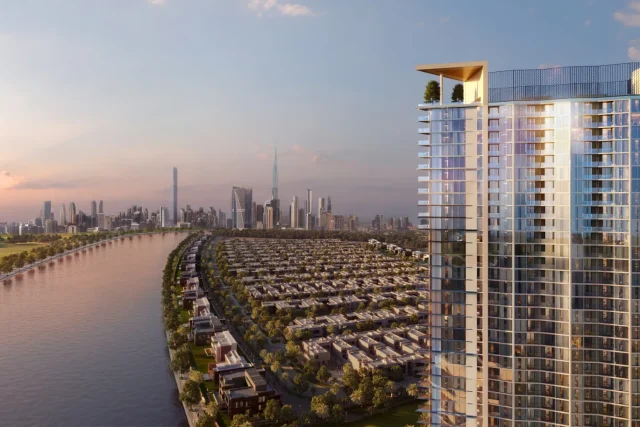
The real estate market in Dubai is on fire. According to data from the Dubai Land Department (DLD) compiled by local media, sales in the first 290 days of 2025 already reached Dh 525.87 billion, surpassing the entire 2024 sales value. Meanwhile, the total transaction value including mortgages and grants hit Dh 709.26 billion — more than 93% of 2024’s full-year total.
Let’s dive into what’s driving this surge, what it means for investors, buyers and the broader economy, and where the risk might lie.
Why the surge?

1. Robust investor demand
The volume of deals is high: 168,540 transactions since January 2025, compared to 180,860 for the entire 2024.The values are climbing, largely thanks to strong demand for residential and luxury properties. As one market observer put it: “sales this year have multiplied sevenfold since 2020.”
2. Government initiatives, regulation, and incentives
Dubai has continued to benefit from investor-friendly policies: such as more relaxed visa/residence rules, foreign ownership options, and global access. One cite mentions that the “Golden Visa” programme has strengthened international investment inflows. On the regulatory front, the transparent DLD data and digitalisation help build confidence.
3. Supply, timing and market momentum
Beyond demand, many developers and sellers are launching new projects, flexible payment plans are being offered for off-plan properties, and international buyers are looking to Dubai for both lifestyle and investment. The forward momentum becomes self-reinforcing: strong performance encourages more activity, which encourages more buyers.
4. Luxury and high-end segment
While overall volumes matter, the luxury/high-end segment is a key driver. Villas, waterfront apartments, branded residences — these are seeing high valuations and attracting global capital. The April 2025 report showed villas and land sales surging.
5. Mortgage and property-grant activity
The numbers show growth not just in sales but in financing and grants. Mortgage activity in 2025 reached Dh 140.66 billion across 33,780 deals; property grants totalled Dh 42.73 billion across 7,637 transactions. This indicates that broad segments of the market — not just ultra-luxury cash buyers — are participating.
What this means for investors and home-buyers

For investors:
- With such strong sales figures, Dubai continues to show itself as a global investment destination. International capital is flowing in, and the market is clearly active.
- High transaction volume and value mean there is liquidity (at least at many levels).
- Off-plan developments with flexible payment conditions might present interesting entry opportunities — especially when backed by strong developers.
For end-users and home-buyers:
- If you’re buying to live in, the demand surge suggests that property values may continue to rise (or at least remain stable) in the near term, although of course nothing is guaranteed.
- But competition is strong. If many buyers are targeting the same segments (e.g., mid-market apartments, villas in popular zones), you may face upward pressure on prices.
- Make sure you understand the specific area, developer reputation, delivery timelines (especially for off-plan), and the total cost (service charges, maintenance, taxes where applicable).
For the broader economy and market watchers:
- Real estate is a significant contributor to Dubai’s economy. Strong performance here helps employment (construction, services), and supports related sectors (finance, legal, property management).
- However, when markets run very strongly for long periods, riskier segments (over-supply, speculative buying) become more likely. That means that while things are good now, caution is warranted.
Key numbers to keep in mind
- First 290 days of 2025: Dh 525.87 billion in sales.
- Transaction count: 168,540 deals in that period.
- Mortgage activity: Dh 140.66 billion across 33,780 deals.
- Property grants: Dh 42.73 billion across 7,637 transactions.
- For comparison: Full-year 2024 reached about Dh 522.1 billion.
- Q3 2025 (Jan–Sept) purchases: around Dh 498.8 billion from 158,200 transactions.
What are the risks & what to watch?
Every boom has potential hazards, so here are some caveats:
Supply-side risks
- When developers build many units, delivery timelines, quality issues, or oversupply in specific segments can weigh on prices.
- For instance, one report by ratings agency Fitch Ratings warned of potential double-digit falls (~15 %) in Dubai residential prices through late-2025/2026 due to rising supply.
Value vs affordability
- With values surging, there’s risk that some buyers may struggle to find sufficient yield or price appreciation. Buyers need to consider total cost, holding cost (maintenance, service charges), and exit strategy.
Global macro and capital flows
- Dubai’s real estate is highly international. Changes in global capital flows, interest rates, currency fluctuations or geopolitical issues can affect investor sentiment.
Area-specific risk
- Not all sub-markets behave the same. Some neighbourhoods might be wildly popular and seeing big growth; others may saturate. Location, developer reputation, completion status matter a lot.
Timing and expectation management
- Even if values continue to rise, the pace may moderate. When markets are very strong, expectations might outpace reality. Buyers should adopt realistic timelines for holding and returns.
What the future might hold
Looking ahead, some likely scenario elements:
- Continued strong interest for mid-market apartments and villas, possibly driven by both local end-users and international buyers.
- More off-plan launches and possibly flexible payment schemes, as developers respond to demand and competition.
- Some moderation in growth rates: while double-digit percentage rises might continue, the pace may slow compared to the sharp ramp-up seen to date.
- A shift in focus to sub-markets or product types that combine value, rental yield, and lifestyle (e.g., affordable luxury, serviced apartments, properties in integrated communities).
- Implementation of more infrastructure and transport improvements in Dubai, enhancing long-term attractiveness.
- Some price correction risk in overheated segments or those with large upcoming supply — meaning selective purchase is prudent.
Final thoughts
Dubai’s real estate market in 2025 is undeniably strong — sales volumes and values are hitting historic highs. For anyone considering buying or investing, this is an exciting moment. But with excitement comes responsibility: due diligence, realistic expectations, understanding of market dynamics and location are all crucial.
If you’re looking into investing in Dubai property, here are three quick take-aways:
- Choose location and developer carefully — not all properties will behave the same.
- Ensure you understand total cost (purchase, maintenance, charges) and your exit horizon.
- Stay informed about supply trends, global investor sentiment, and regional regulation.





Leave a Reply